For the past couple of weeks I have been enchanted by a Facebook site whose entire focus is looking back at my old hometown, Delhi Ontario.
It has been a treat, viewing grade school pictures and tagging names to people I haven’t seen in 60 years. There have been renewed conversations with these long lost friends. While the site’s members are asking others to remember their shared experiences, it has also rekindled some memories of my own that I clearly had forgotten. Running central through these experiences is Big Creek.
Big Creek is about 40 miles long from its smallest tributary running into Windham township, at the northern border of Norfolk County. As it heads south towards Lake Erie it gains volume and girth, first with the addition of Brondy Creek north of town, then Cranberry Creek, from the west, in Middleton, then Trout Creek and Silver Creek come from the east, in Charlotteville. Further south it expands as Venison Creek flows in from the west of Walsingham.
It drains west Norfolk through a valleyed web of locally named brooks, streams, rivulets, freshets and runs that on a map looks like the willowy profile of a vast, exotic plant. Through its valleys grow a robust Carolinian forest, distinguished by towering beech, hickory, walnut, sassafras, butternut and tulip trees. The woods are alive with rich scents and sounds, modified by the steady gurgle of flowing water. Underfoot we find marsh marigolds and vast spreads of skunk cabbage.
Along every bank there is a path, both sides, worn deep by the feet of literally centuries of generations of natives, settlers, small animals and small people. They are there to walk, fish, camp, trap, hunt, swim, wade and stare deep into the current’s constant pushing of sand and silt towards the lake.
Fighting the flow are small fish– trout: brook, brown, and occasional suckers which vacuum the river bed. They are scurrying against the riffles to sink deep into the green pools under fallen trees and trapped logs. Every elbow in the river is the occasional site of fishers dangling a monofilament line over the pool, waiting for a tug.
As a boy, no more than 8 or 9, I accepted the waterway as open territory for discovery, as did all of my friends. Big Creek was as accessible as the school yard and main street. But more inviting, as it constantly delivered new events at every turn.
At the north end of town, a half mile pedal, racing down swimming pool road, a driveway took us into Deerlick, a rustic retreat. Some church owned it, and sent their meditating members off to think, and maybe relax. We wheeled in there on our bikes, and stopping in the woods, a few hundred yards, dumped our clothes, and jumped into a clear, shallow stream that flowed into the mother creek.
Icy water, 12 inches deep! We hung in long enough to claim a short rebellion against our parents’ warnings to stay out of trouble. Somewhere back towards the road we could hear the occasional rumble of cars over a steel bailey bridge paved with heavy, loose, oak timbers, and a pounding reminder that civilization wasn’t too far off.
The little stream poured into a larger current, and a few minutes back to Delhi, past the horseshoe, which was an abandoned oxbow in the creek, and one could see the old swimming hole. A sturdy wire bridge was suspended over the creek to reach the other side.
This was a service club’s effort to offer some fun for the youth of Delhi. At a gentle bend in the creek, the water deepens as it wraps around a sandy beach, grossly out of place in the woods. Were it not for Norfolk’s sandy composition, there would be no beach. Nevertheless, there is a place to suntan, a change house, and every weekend the screams and chatters of a host of jubilant kids spread across the creek waters as they drift slowly by.
The swimming hole is just that. Shallow on the beach side, the creek bed drops off immediately into a dark, murky green pool. The big kids jump off a diving board into the dark waters. On the beach side, I walk out to the end of a small dock and jump in, expecting to hit bottom, waist deep. There is no bottom, to my surprise, and am shocked enough to inhale two lungs full of water. My last memory is a stream of yellow bubbles rising before my eyes.
I woke up in the change house some time later. Luckily, I had been missed by a lifeguard who jumped in and pulled me out. She must have been terrified as they pumped me and shook me in the change house. I awoke under the eyes of a group of concerned kids. I had a horrific case of the hiccups which lasted all the way home as my brother escorted me. When I met my parents, I said I had taken a mouthful. A couple years ago, I sent that lifeguard a note with a picture of my family and grand kids. I pointed out they were her doing, and thanks.
The site was eventually downgraded to a camp for out-of-work transient tobacco workers, and the service club built a new pool up by the rink. Today the area is entirely unrecognizable, and the bridge is gone.
The creek flows south, just behind a cliff. At the top is Talbot Street, and that is the address of the Anglican church, St. Albans, then St Casimir’s the Lithuanian church, and St John Brebuf school. It is one of the oldest streets in town, and is named after John Talbot who mapped southwestern Ontario, earning himself a throughway called the Talbot Road. More currently it is Highway 3.
Just before Big Creek curves under the bridge, there is a slow spot. In the winter the ice forms easily, and we often went down to play hockey on the grey skin of ice in the winters. One had to be careful as open water drifted close by, and our mutual responsibility was to stop the puck from sliding into the icy black that bubbled and melted the edges of our rink.
After the bridge, the creek has a run of a couple hundred yards in shallow waters before it hits Quances Dam. There are stacks of rough cut wood there, six feet high, air-curing. I have climbed on those boards and waited for hours to spot the groundhogs coming out on a spring day to catch some noon sun. The brownie camera I hold takes vague, grey pictures, but they are gold to me, better than Disney, actually.
Big Creek jams up at the dam. The dam is old, originally placed there in 1830, and powered the lumber mill and feed mill owned by the Quances, one of Delhi’s earlier families.
In my younger years there, I never sensed that lumber was a business. The dam was for our entertainment entirely. Water cascaded over the concrete, separated by a ten-foot-high pill box between two spillways. We would jump into the pillbox to stare up into the lip of the dam that was under a steel bailey bridge. We looked for whatever was coming down, and occasionally for some hardy fish that thought they could jump up into the water above.
In the pool below there were small retention ponds built out of stones put there by fishers who wanted to keep their catch alive but captive, until they went home. One day we played in the pond looking for crayfish and found a nest of lamprey eel. They were just babies, about six inches long, flashing silver in our hands as we grabbed for them. They would grow eventually to attach themselves to the game fish in the stream, and in Lake Erie. Evil little slitherers.
Around the corner, there once was a hanging bridge that crossed the creek. I never saw it, but it was a convenience for folks who didn’t want to walk around Western Avenue to get to the dam, which was a rendezvous for many purposes. Farther down, the creek flows under the road, and past Stapleton’s stone welding and metal fabricating shop that is a landmark. When we built a go-kart, he built us an axle for the wheels.
Further south, the pungent odor of sulphur fouls the air. We have frequently walked down the dirt road to the town’s sewage plant. There, we would pass by a one-story cinder block building, lonely, unattractive and foreboding. Beside it, a fenced off water distribution system carouseled around a 60-foot-wide circle, dripping treated water into a bed of rocks. There was an intrepid group of truants who climbed the fence and rode the pipes one afternoon, reportedly. There was mention of a police visit. It was during school hours, so we missed that. Nevertheless, we were in awe of their bravado.
Beside the sewage plant springs a bubbling fountain of sulphur water. It boils out of the ground, exuding its trademark stench, and leaves a milky film over the rocks as it flows down to the creek. Like a saviour, Big Creek takes both the sulphur water and the treated sewage water away, cleansing the town of its trespasses.
A couple more bends in the creek and it curves past a reforested pine woods. There were many Saturdays when we sat in those woods, loaded up with a giant bottle of Coca Cola and a pack of cigarettes and solved the problems of our world, mostly school, teachers, parents and girls. The meandering creek took our troubles away with it.

The new Lehman’s Dam, equipped with fish ladder forms a magnificent small lake extending to highway 3.
Just before it hits another bridge, the waters are joined by the North branch as it is called locally, and Lehman’s dam traps a small lake of water further upstream. If one ventures up North creek, it eventually cuts under highway 3. Just around the corner we camped up there for a night in a small canvas wall tent. Fire, food, smokes, our friendly companion dog for company, and the calls of mourning doves made for a pleasant vacation in the woods. We were 11 years old, and living the good life.
Back down at Big Creek proper, it travels south under the railway trestle. Grand Trunk used to run trains over it, and then the CNR. The trestle still stands today, black and rusted, out of use, and it is a monument to the energy and will of a bygone business generation. 50-year-old trees are growing among its foundations. When I was very young that same rail line had steam engines pounding over the rails, and I can remember their flute-like whistles, nothing like today’s diesels with their air horns.
This patch of creek is a highway for foot traffic. We often came here, walking down from William street, over the tracks, and into the woods. On any given Saturday this was a destination hike, punctuated by a campfire, and a sizzling frying pan of hamburger, potatoes and onions.
There was a particular elbow that we would camp on, where the creek rushed by in six inches of rapids. Wandering out into the water, I fetched a peculiar rock that stuck out among the froth. Picking it up, it looked like a brick, but very smooth and scarred with shallow scallops like someone had scraped the sides with a spoon. It was block of flint.
Not knowing this, but still intrigued, I hefted the brick into my knapsack and took it home. There, I chipped away at it with my dad’s hammer, and amid the sparks, broke off sharp thin wafers of flint. Before long, I was failing, but enjoying the attempts at making flint arrowheads. Just another gift from the creek. I still have the rock today.
On Saturdays we went for bike rides beyond the tobacco factory. The gravel road led to the long sloping Dick’s Hill intersected again by Big Creek. The steel bridge there was a bailey construction with rumbling timbers that shook with every car that crossed over. From that bridge you could fish, spit, drop stones and apples to the smoothly passing water below. The town council closed that bridge in the 70s, and cut off the neighbours to the west of the creek.
A couple hundred yards in, at another elbow we camped in a grassy clearing over a 24th of May weekend: wall tent, food, fire and our same faithful dog. It was a delicious, sunny warm afternoon followed by a quiet star-lit night. Totally inspired, we rigged up a large tripod, and boiled a 5-gallon drum full of water and took showers, then turned in to bed, wet heads on a mattress of pine bows. The dog wouldn’t enter the tent and slept outside, no doubt looking for varmints. Next morning we woke under a heavy chill, with horrendous, thick, throaty coughs. Outside, the dog slept, covered in a heavy coat of frost.
A couple miles down from Dicks Hill are the remains of Croton Dam. We got there by gravel road and bike. This structure was built over 50 years earlier in 1907, and blew out in 1937. By the time we discovered Croton it had a young forest of trees growing out of its foundations. The portions of the dam still standing are worthy of climbing and walking, all the time staring up the steep hill on the other side of the creek. Looking upstream, it’s easy, and stunning to visualize what the mill pond used to look like, stretching back perhaps half a mile. Croton provided Quances Mill with 60 cycle hydro, long before Ontario Hydro.
Our furthest bike pursuit of Big Creek was Lynedoch. This little hamlet is poised in a valley around the bridge over the creek. Just south is an orderly grove of walnut trees planted decades before: probably thirty or forty 50-foot trees in neat rows across the flats.
As the creek wanders past Lynedoch to another elbow, you can still walk up to the field above where there are arrow heads and tools left behind by an Indian village centuries ago. Just another find by the water’s edge if you care to look.
Having unloaded my memories of Big Creek, it comes to mind just how lucky we were as kids to live in an unfettered, free-range world, to wander for miles, away from home. By today’s urban standards, our parents would all be in court facing child abandonment charges. Thanks to their trust, and maybe to their post-war sense of relief, we were launched optimistically to explore and learn, full time.
All the while, Big Creek was our playground and classroom.
Thanks for hanging in there and getting this far. This was a long essay, but so is the creek. Please like and share this one! Thanks also to John Waite, Randy Goudeseune , James Bertling, and Alice DeGeyter whose Facebook posts supplied some of the images.


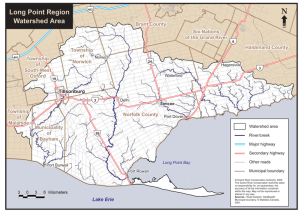

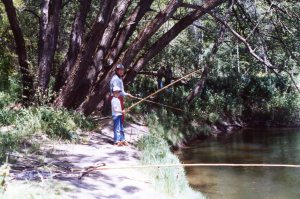
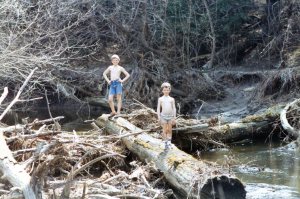

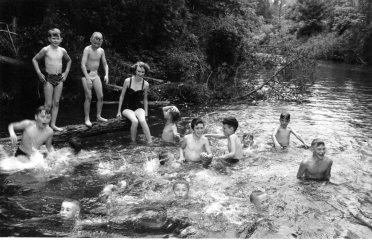


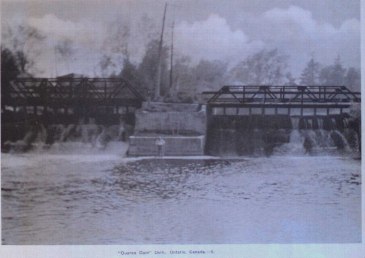

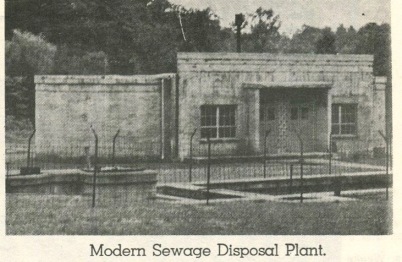






Really brought back memories os summers in Delhi and swimming in Big Creek.
LikeLiked by 1 person
Hi Brenda! Glad you liked the post. Big Creek: sandy bottom, and cold! Thanks for writing!
LikeLiked by 1 person
A great well written piece,Phil,thanks for your memories,we used to bicycle down to a swimming hole about 3.5 miles N/O Delhi only a couple miles from our Farm on Con 10 Windham. Sometimes we would go fishin’ at Sulphur Springs near the Dertinger Farm.
LikeLike
Living in the country, Keith! Nothing like it! Thanks for writing!
LikeLike
Great article, Phil. I have similar memories of playing in the woods, fishing, go-karting, doing the occasional naughty. I skirted around you in the ’60s, while boating on Lake Erie, then living in Detroit (we made one jaunt up to London, Ontario). Now, I’ll have to check out Facebook to see if my old hometown has a similar nostalgia page.
LikeLiked by 1 person
Hey Peter! Lake Erie is the shallow lake, but not without its dangers. London was the go-to for many shopping trips, and also the home of the University of Western Ontario, which graduated many Delhi kids. This article received a lot of like readers who grew up in Delhi, part of Norfolk which is the relatively undiscovered gem of Southern Ontario. It’s quite a beautiful countryside. Thanks for writing!
LikeLiked by 1 person
When was the dick’s hill bridge torn down. We walked the trail just after Christmas I hadn’t been there since the late 1980’s and sad to find the structure totally gone. Hoped my kids could have seen it. Fond memories as a kid.
LikeLike
I think the late 70s. It was a Regional Municipality government decision. I felt sorry for this folks on the west side, suddenly cut off from Delhi.
LikeLike
Phil,
It was great to meet you and your wife tonight at Dan’s party. I’m glad we had the chance to talk a little bit about your writing and learn more about your family.
I’ve had this email sitting in my draft folder for several months, but for some reason, I never got around to sending it. It somehow seems apropos to do so now, even if in my ramblings tonight I told you much of what you will read below. I guess I just wanted to reaffirm my appreciation for what you do.
I’ll definitely have to get your book!
Thanks. Mike
– – – – – – – – – – – – – – – – – –
Great post, Phil. I really enjoyed it.
My father was a teacher, but has also written a weekly column for about 25 years for my hometown newspaper. It started out as a critique of local theater, but when there weren’t any performances going on, he’d write about his reminiscences of growing up on a dairy farm in northern Wisconsin. After a while, the column about his own experiences — and the other eclectic stuff that was in his head — became so popular that the editors gave him free reign to write whatever he wanted, whenever he wanted.
Even after the newspaper was bought out by a large conglomerate and they changed formats, killing most of the editorial and feature columns in favor of “real” news, including his column, he continues to write, emailing his stories to hundreds of people all over the country who’ve requested to receive it. It’s gratifying that so many people enjoy it. I’ve told him he should post it online like your blog, but he’s not wanted to go through the learning curve of setting it up. I may do it for him, so I can compile what he’s written over the years, and maybe even publish it as a book.
He’s in the late stages of cancer, but continues to write every week. I think he almost feels like he’d be letting his readers down, and that’s a good thing, as it keeps him coming back to the keyboard. I’ve told him that after he’s gone, this will be a wonderful record of his thoughts and experiences. I feel almost like I was there with him in his childhood, just from reading his words, and I felt that very same thing when reading yours. Even if the landscape has changed, buildings and bridges and fields and woods are now gone, the important places and memories of youth live on forever through your great stories.
LikeLike
I would like to meet your Dad some day! You certainly can publish his work; I used Blurb.com for my two books and will probably do yet another– a collection of these posts too. Jane and I enjoyed meeting you. By the way, another writer that your Dad may know, and revere, is Stephen Leacock. He was Canada’s Mark Twain, and was a cornerstone in family and innocent humor. Last recommendation, Stuart McLean, recently deceased, about my age. Check out “The Vinyl Cafe”. All good stuff! All the best to you Mike!
LikeLike
Phil Just found your article about Big Creek I lived on Norfolk road 2 about a mile east 1953 to 1960. All the local kids showed up when ever we didn’t have to work in Tobacco. The water snakes stayed to the south while we were swimming. Learned to swim there. We regularly visit family in Norfolk. Use Rd. 2 brings back memories.Had the experience of selling Tobacco at the Warehouse in Delhi. Great Article. Thanks David Frew.
LikeLike
Hi David! Thanks for your note! I have emailed a lengthier reply. Delhi was a great place to grow up. The Horseshoe was packed with snakes, wasn’t it?
LikeLike
David, I have been reading—with great interest and enjoyment— about the Lake Erie Quadrangle. Are you the co-author of this terrific work? Please let me know, thanks!
LikeLike
Thanks for the memories, especially your description of Dick’s Hill. I grew up on the first farm on the left at the top of the hill. I certainly remember the rumbling of those loose boards on that bridge as we drove into town.
I camped and fished at that first bend in the river many a time, including a winter overnight as a scouting requirement with Dave Baxter, on the knoll of pine trees on the edge of the clearing.
Kids today will never have the those same experiences. I guess one could say that we could taste those experiences of Tom Sawyer.
Thanks for arousing those fond memories!
LikeLike
HeyPercy! Dave Baxter was in my confirmation class at St Albany’s in Delhi. I used to bike up your side of the hill. I even encountered a wild dust devil across the road from your farm. Totally spooky. Glad you got to read Big Creek. There are a dozen more stories on my site about Delhi and tobacco. Please enjoy! Thanks for writing!
LikeLike
Do you have and idea/inkling as to when the ‘swimmin hole’ was opened and closed ?
LikeLike
I believe the Big Creek swimming hole started in the late 1940s. By 1960 had been erased due to repurposing for transient labor shelter. The new pool was opened in 1968, just west of the Delhi ice rink.
LikeLike